
ELECTRONIC DESIGN
January 25, 1999
Analog Outlook
Exploring the world of analog, mixed-signal and power developments
Speedier ADCs Pick Up More Bits
And Samples
Manufacturers Are Combining Process Improvements With Novel Architectures
To Attain Higher Resolution And Speed.
Ashok Bindra
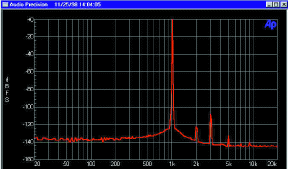
Art Courtesy: AKM Semiconductor
The ongoing revolution in digital communications is dramatically impacting
the performance of analog-to-digital converters (ADCs) as systems
designers shove the ADC closer to the antenna.
Sampling at the IF of the wideband base-station receiver or digitizing
multiple channels in a software radio translates into a higher dynamic
range with faster conversion and better signal-to-noise ratio (SNR),
as well as improved spurious-free dynamic range (SFDR). Portable
cellular handsets are demanding this level of performance at lower power
consumption, in addition to micro-miniature packages.
The proliferation of digital techniques in consumer, industrial, and
instrumentation applications is propelling improvements across the board,
starting at 8 bits and reaching all the way up to 24 bits. Consequently,
ADC manufacturers are combining advances in CMOS, biCMOS, and complementary
bipolar (CB) processes with innovative architectures to develop a broad
portfolio of high-performance ADCs.
Communication ADCs
Responding to the communications call, high-performance data-converter
suppliers have begun to release monolithic 14-bit ADCs capable of sampling
at 65 Msamples/s, and offering a 75-dB signal-to-noise ratio (SNR) and
an SFDR over 90 dB. Two recent introductions boasting this level of
performance from 14-bit ADC chips come from Analog
Devices (ADI) and Burr-Brown.
While ADI has combined its high-speed complementary-bipolar process with
multipass circuits to deliver the single-chip AD6644, Burr-Brown
has tapped its low-cost 0.5-µm CMOS process to ready the monolithic
ADS852.
According to ADI,
laser trimming at the wafer level guarantees 14-bit accuracy from the 14-bit
AD6644.
The use of dither enhances SFDR performance to 100 dB. "This
allows the ADC to start conversion at the IF to replace traditional IF
and RF filters with predictable digital filters, thereby lowering the component
count, as well as the cost of the receiver," states Scott Behrhorst, marketing
and applications manager for ADI's Digital Radio Group. Operating from
a single 5-V supply, the AD6644 includes an on-chip track-and-hold (T/H)
circuit and a reference to achieve an input bandwidth in excess
of 450 MHz (Fig. 1). It provides CMOS-compatible digital outputs
at 65 Msamples/s. Packaged in a 52-pin thin quad flatpack (TQFP), the AD6644
typically dissipates 1.2 W. Efforts are under way to extend this speed
to 100 Msamples/s, with added value.
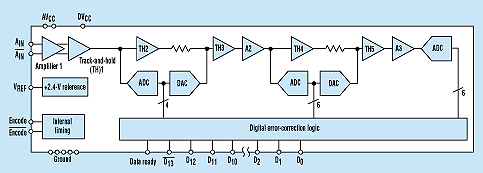
1. An innovative multipass circuit in Analog Devices' 14-bit, 65-Msamples/s
AD6644 monolithic converter allows it to maintain a 90-dB SFDR through
the Nyquist band. Made on a complementary-bipolar process, the ADC has
a typical SNR of 78 dB.
Meanwhile, ADI also plans to implement this architecture in submicron
lithography to boost the sampling rate beyond 100 Msamples/s at 12 and
14 bits. The company intends to achieve a sampling rate of several hundred
MHz at 12 bits by the summer of 2000. Concurrently, it's also investigating
a 16-bit, 65-Msamples/s version for radar applications.
Likewise, Burr-Brown's ADS852
utilizes a proprietary input T/H circuit design that allows the 14-bit
pipelined
ADC
to track at Nyquist rates, without any loss in spurious response. "To maintain
the integrity of the held input signal, all aspects of the design have
been optimized to reduce errors resulting from clock feed-through, capacitor
mismatch, and op-amp open-loop gain," says Patrick Kirk, strategic marketing
manager at Burr-Brown. The op-amp open-loop gain and bandwidth were optimized
for each stage in terms of the settling time and power dissipation.
To obtain an open-loop gain of about 100 dB and a unity gain bandwidth
in excess of 1 GHz, a cascaded op-amp architecture was implemented in 0.5-µm
CMOS. Says Kirk, "The new 14-bit, 65 Msamples/s ADS852 has been designed
to give the necessary carrier-to-noise (C/N) dynamic range demanded
by wideband base-station receivers. It achieves a C/N ratio of 104 dB without
the use of an AGC." To ensure no missing codes at 14 bits, the ADS852 incorporates
digital
error correction (Fig. 2). Designed for single 5-V operation,
it comes with many other bells and whistles. Some of these include a low
jitter
of
0.25-ps RMS, differential or single-ended inputs, and a selectable full-scale
input range. Typical power consumption is 650 mW. It comes in a 48-lead
TQFP.
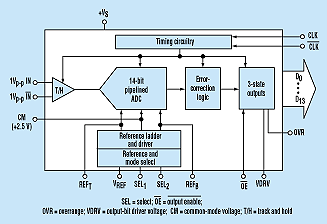
2. This 14-bit, 65-Msamples/s ADC from Burr-Brown has been architected
to give the necessary carrier-to-noise (C/N) dynamic range required by
wideband Groupe Speciale Mobile (GSM) receivers without the use of AGC.
The high-performance 14-bit ADS852 is made on a 0.5-µm CMOS process
which cuts power consumption down to 650 mW.
For applications that need lower power, Burr-Brown is offering a 400-mW
version, the ADS851, which samples below 65 Msamples/s. Aside from
wideband communications receivers, the 40-MHz chip targets ultrasound and
charge-coupled-device (CCD) imaging. The company also is sampling a 12-bit,
75-Msample/s ADS808 for those designers who need higher sampling
rates, but can live with 12-bit resolution. Like the ADS852/1, the ADS808
is offered in a 48-lead TQFP package. Yet Kirk does not see the 14-bit
ADCs going down to 3.3 V very soon. Instead, he foresees the integration
of digital-down converters (DDCs) riding the tail end of these high-performance
ADC ICs later in the year.
National
Semiconductor and Texas Instruments,
both major players in communications, also are keeping a close tab on ADC
developments. In line with its digital-signal-processing (DSP) solutions
strategy, TI is preparing high-speed ADCs with resolutions of 12 bits and
higher, as well as on-chip interfaces to its DSPs. Leveraging its
strength in deep-submicron CMOS, TI's goal is to develop an 18-bit, 200-Msamples/s
ADC for cellular base stations by 2003. While no details on the
TI products are available, it's expected that these ADCs will hit the market
in the second quarter. Like Burr-Brown, TI also favors CMOS for lower power
and higher integration. The company's CMOS process progression shows 0.18-µm
geometries this year, with migration to 0.15 µm by the year 2000.
TI expects to implement 0.09-µm effective channel lengths by 2001,
moving to 0.07 µm by 2004.
On the other hand, National
Semiconductor's Comlinear Division, Fort Collins, Colo., will continue
to tap the benefits of submicron biCMOS to extend the performance of its
12-bit ADC chip for wideband digital receivers. In the works is a 14-bit
version expected to be released sometime this quarter.
"While a 14-bit ADC seems adequate for addressing the needs of base-station
receivers based on wideband CDMA standards, GSM900 receivers converting
to wideband designs require even better performance," says Kurt Rentel,
National's marketing director for system products. According to Rentel,
wideband GSM900 designs require an extra 10 dB of dynamic range with higher
SNR and improved distortion performance (Fig. 3). Toward that end,
National is looking to develop a 16-bit ADC with better noise performance.
However, additional details on this project were unavailable. Meanwhile,
the company is readying a 14-bit ADC with rates between 5 and 8 Msamples/s
for xDSL modem applications. Based on 0.5-µm CMOS, the 14-bit ADC
for xDSL modems is planned for introduction in the fall.
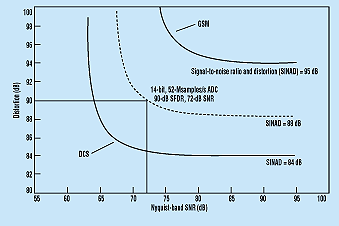
3. Wideband GSM receivers have stringent ADC requirements for distortion
and SNR. As a result, new lines of fast-sampling, 14-bit ADCs are offering
over 60 Msamples/s with a minimum SFDR of 90 dB and SNR of 72 dB to meet
such challenges.
Another key contender joining the wideband fray is Harris
Semiconductor. While adequately serving narrowband receiver designs
with its current line of 12- and 14-bit parts, Harris foresees a trend
toward wideband receivers in base stations. "These receivers are demanding
ADCs that can process large bandwidths and maintain the dynamic range,"
says Harris' product marketing engineer, Juan Garcia. Consequently, Harris
is developing competitive, 0.6-µm CMOS, 14-bit ADCs using a multistage
pipelined circuit.
High-Quality Imaging
The digital revolution also has pervaded the world of imaging and
video systems. For improved quality, these applications seek higher-resolution
converters with accuracy as high as 14 bits. Several vendors have readied
14-bit parts with the linearity and accuracy needed in these applications.
Furthermore, they're exploiting pipelined architectures to obtain
acceptable time-domain specifications for noise, bandwidth, and fast transient
response.
Maxim Integrated Products' answer
to these requirements includes the 2.2/1-Msamples/s, 5-V MAX1201/1205
ADCs.
For those needing even higher resolution for improved gray scale, the company
has readied the 16-bit, 1-Msample/s MAX1200. The 1200/1201/1205
versions come in 44-lead metric quad flatpacks (MQFPs). According to Maxim's
business manager, David Bernel, "The converters' very low differential
nonlinearity (DNL) error of ±0.3 LSB and self-calibration
on demand provide a cost-effective alternative to expensive hybrids
in demanding, high-resolution imaging applications."
Other contenders pursuing this activity include Analog
Devices (ADI), Exar
Corp., Linear Technology (LTC),
National
Semiconductor, and Signal Processing Technologies
(SPT). Like Maxim, ADI
has adopted a differential pipelined architecture with digital correction
logic to guarantee no missing codes over the full temperature range.
Indeed, ADI has extended the speed of its CMOS pipelined, 14-bit AD9240
to 10 Msamples/s, while dissipating only 285 mW. Tailored for single 5-V
supply operation, it comes in a 44-pin MQFP.
In the meantime SPT, which has been
pushing the performance envelope of 12-bit ADCs for CCD cameras, sensors,
medical imaging, and other applications, has set its sight on 14-bit solutions.
According to SPT's director of marketing, Rick Mintle, the company is developing
a 14-bit, 0.5-µm biCMOS ADC chip with a 20-MHz conversion rate that
includes a differential pipelined architecture with on-chip self calibration.
"The extra 2 bits mean the LSB is four times smaller," explains Mintle.
"So, the designer must pay attention to signal conditioning, layout, bypassing,
and grounding. Also, the differential input makes external noise and common-mode
noise cancel out." Like other 14-bit ADC suppliers, SPT is offering evaluation
boards that should help designers better understand the device.
LTC's current solution for
CCD camera, sensor, medical imaging, and other applications is the 12-bit,
10-Msamples/s pipelined LTC1420. But the company also is
readying a 14-bit version with attractive INL and DNL specifications.
The 250-mW, 14-bit device will provide higher resolution with linearity
specifications similar to its 12-bit kin, as well as high SINAD (SNR
and distortion) and SFDR. "While faster parts can sample more
pixels in a single clock cycle, the higher number of bits allow more shades
of gray in such applications," says Willie Rempfer, LTC's design engineering
manager for data-converter products. The pipelined 14-bit part will sample
within the next six months, with production to follow soon after. The 12-bit
LTC1420 is available in a 28-pin shrink SOP (SSOP), while the 14-bit model
will come in a 36-lead SSOP.
Improving Audio
The insatiable quest for better audio performance is forcing designers
toward 24-bit ADCs with a 96-kHz output data rate and very high SNRs and
SINAD. Even 192-kHz versions are on the horizon.
To support the newest standard for high-end audio systems, Asahi
Kasei Microsystems (AKM) Co., a subsidiary of Japan's Asahi Chemical
Industry Co. Ltd., has extended its dual-bit delta-sigma architecture
to
support higher output data rates with 24-bit resolution. The result is
the AK5393, a 24-bit, 128X-oversampling, 2-channel stereo
converter with data rates as high as 108 kHz. It also flaunts a dynamic
range of 117 dB and SINAD of 105 dB. On-chip are digital low-pass
and high-pass filters and an offset calibration, easing system design.
To provide 128X oversampling, the analog modulator samples the input at
6.144 MHz. The converter features differential inputs to minimize
the input noise (Fig. 4). Additionally, the manufacturer recommends
more attention at the input section to maintain audio quality at the output.
Housed in a 28-lead SOP package, the AK5393 consumes a maximum of 630 mW.
A 192-kHz version is slated for the second half of this year.
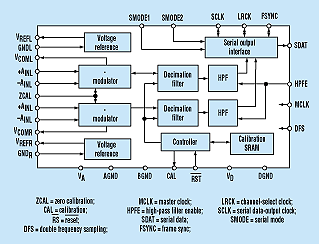
4. An enhanced dual-bit, delta-sigma architecture is implemented
in CMOS to give AKM's 24-bit, 2-channel AK5393 ADC a dynamic range of 117
dB with a SINAD of 105 dB. It features differential input, and supports
output data rates of 96 kHz.
Another major proponent of the delta-sigma 24-bit solution for
high-end audio is Cirrus Logic's Crystal
Division, which is currently focused on cutting the power consumption
of its 24-bit, 96-kHz CS5396/97 by 30 to 40%. The trick is to do
this without compromising the 120-dB dynamic range and the -105-dB total
harmonic distortion plus noise (THDN). To obtain this performance,
Crystal's designers are optimizing the digital filter and modifying the
architecture to run the digital portion of the design on 3.3 V. Expected
to be sampled later in this quarter, the CS5398 is pin-compatible
with the - CS5396/97.
Crystal also is investigating a multibit delta-sigma architecture
as
it prepares to push the dynamic range of these converters to 125 dB. The
company's roadmap indicates that multibit delta-sigma solutions will be
ready for release to the fabs by year-end. "In using such high-performance
converters, the system designer must ensure that input op amps and buffers
are extremely low noise, and the layout is proper," says Tom Stein, Crystal's
marketing manager for audio converters.
ADI
plans to enter the market later this year. Observing increasing activity
in this high-end professional sector, it's preparing a 24-bit, 96-kHz solution
using 0.5- µm CMOS.
Data Acquisition
Many low-frequency applications like sensing, vibration analysis, seismic
data acquisition, medical imaging, and instrumentation are seeking precision
as high as 24 bits.
Two notable introductions to serve this world include
LTC's
LTC2400 and ADI's
AD1555. Although both of these solutions use delta-sigma modulation
techniques to achieve 24-bit resolution, there are many differences
on-chip. While the LTC2400 is implemented in 2-µm CMOS, the AD1555
is based on biCMOS. The CMOS LTC2400 incorporates on-chip
digital filtering and decimation.
The biCMOS AD1555, unlike the LTC2400, requires an
accompanying FIR digital filter/decimator - the AD1556 -
to realize the full potential of the ADC. On the other hand, keeping the
digital filter separate results in a very high SNR of 118 dB. Additionally,
the AD1555 implements continuous-time, delta-sigma operation with a switched-capacitor
feedback digital-to-analog converter (DAC) to obtain a guaranteed low distortion
of -116 dB. "This feature eliminates the need for an external anti-alias
filter," notes Alain Query, senior applications engineer at ADI. "Also,"
he adds, "the external CMOS-based FIR digital filter provides optimized
output data rates from 250 samples/s to 16 kilosamples/s." The AD1555 has
a programmable gain amplifier (PGA), as well as a multiplexer. It consumes
80 mW, and comes in a 28-pin, plastic leadless chip carrier (PLCC). Likewise,
the companion AD1556 is rated for 20 mW dissipation, and is offered in
a 44-lead PLCC.
Testing such high-resolution ADCs is difficult
and expensive. To simplify the task, ADI
is considering the integration of a DAC to generate a high-purity signal
on the same die. Furthermore, to reduce the footprint and cost, the company
is checking into developing a multichannel digital filter that can handle
several modulators. Meanwhile, LTC is working on adding features to the
recently unwrapped LTC2400 (Electronic Design, Sept. 1, 1998, p. 68). Key
enhancements include higher speed, lower noise, and the addition of a multiplexer.
Also in this race is Burr-Brown,
with plans to sample a lower power version of the second-order, delta-sigma,
24-bit ADS1210/1211 by the end of the first quarter. The newest
offering will include an 8-channel differential input multiplexer. Simultaneously,
the company also is readying a 20-bit, 25-kHz ADS1250 with an on-chip
PGA and digital filtering, as well as a DSP interface.
 Copyright© 1999, Electronic
Design, Penton Media, Inc. All Rights Reserved
Copyright© 1999, Electronic
Design, Penton Media, Inc. All Rights Reserved





